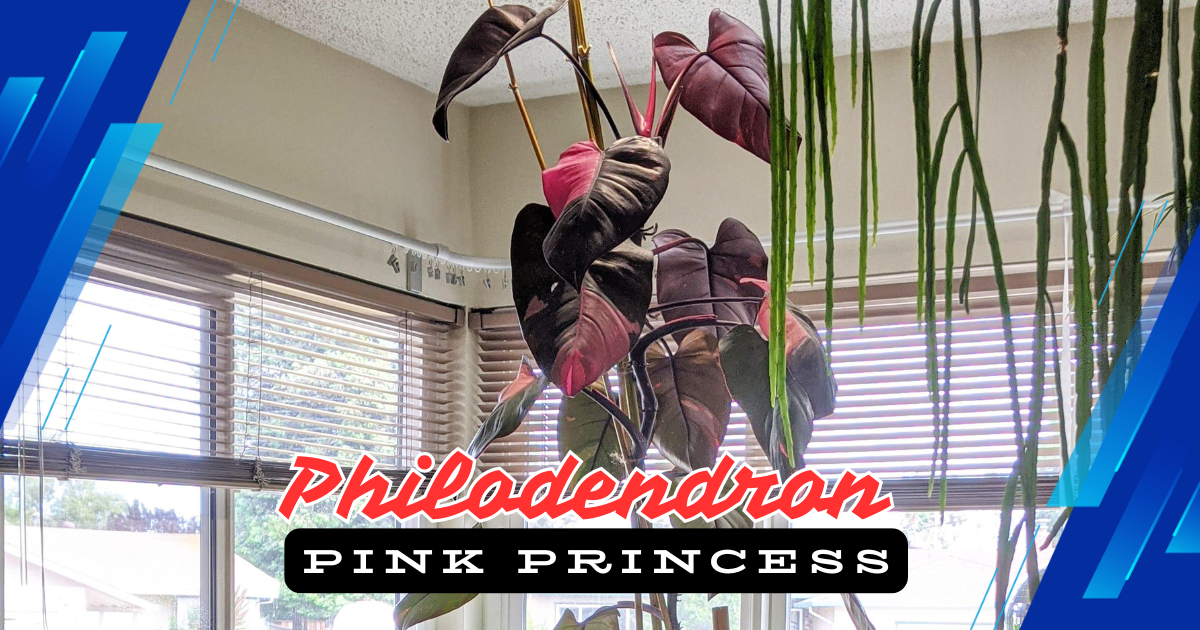The Philodendron Pink Princess has quickly become one of the most coveted houseplants among plant enthusiasts. With its striking pink variegation set against deep green leaves, this tropical plant brings an exotic flair to any indoor space. However, growing and maintaining a Philodendron Pink Princess requires careful attention to its specific needs to ensure the plant thrives and keeps its unique coloring.
In this blog post, we’ll go over everything you need to know about Philodendron Pink Princess care, from ideal light conditions to propagation techniques, and share why this plant is worth adding to your collection.
1. What is Philodendron Pink Princess? A Rare and Popular Indoor Plant
The Philodendron Pink Princess is a hybrid variety of the Philodendron erubescens, known for its beautiful variegated leaves, which feature patches of bright pink mixed with deep green and burgundy. Native to the tropical rainforests of South America, this plant thrives in warm, humid environments but can adapt to indoor living if its care needs are met.
What makes the Pink Princess stand out is its rare pink coloration, which is due to a genetic mutation in the chlorophyll production process. This makes the plant not only beautiful but also highly sought after by collectors. As a result, the Philodendron Pink Princess has become one of the most popular and expensive houseplants on the market today.
2. 5 Essential Care Tips for Philodendron Pink Princess
To grow a healthy Philodendron Pink Princess, it’s important to provide the right balance of light, water, humidity, and nutrients. Here are five essential care tips to ensure your plant thrives indoors:
1. Light Requirements
- The Philodendron Pink Princess prefers bright, indirect light to maintain its vibrant pink variegation. Too much direct sunlight can scorch the leaves, while insufficient light can cause the plant to lose its signature pink color. Aim to place your plant near a north-facing window or filtered light from a south-facing window.
2. Watering Schedule
- Overwatering is one of the most common mistakes with Philodendron care. The Pink Princess likes its soil to dry out slightly between waterings. Water the plant when the top 2 inches of soil feel dry to the touch. Be sure to use a pot with drainage holes to prevent water from accumulating and causing root rot.
3. Humidity Needs
- As a tropical plant, the Pink Princess thrives in high humidity. Keep the air around your plant humid by using a humidifier or placing it near other plants. A humidity level of around 60-80% is ideal.
4. Best Soil Type
- Use a well-draining potting mix that retains some moisture but allows excess water to escape. A mix of peat, perlite, and orchid bark works well for Philodendrons, ensuring that the roots stay healthy and well-aerated.
5. Fertilization
- Fertilize your Philodendron Pink Princess every 4-6 weeks during the growing season (spring and summer) with a balanced, water-soluble fertilizer. Avoid over-fertilizing, as this can lead to salt build-up in the soil and harm the plant.
3. Philodendron Pink Princess Light Requirements: How to Achieve Vibrant Pink Leaves
One of the most appealing features of the Philodendron Pink Princess is its pink variegation. To keep this vibrant color, it’s important to provide the right amount of light.
Why Light Matters for Pink Variegation
The pink sections on the leaves are the result of a lack of chlorophyll, meaning they don’t contribute to the plant’s energy production. As a result, the Philodendron Pink Princess requires sufficient light to sustain itself while maintaining its variegation. However, too much light can cause the pink parts to turn pale or burn, while too little light will cause the plant to revert to green.
Optimal Light Conditions
Aim to provide your plant with bright, indirect light. You can achieve this by placing it near a window with filtered sunlight or using sheer curtains to diffuse direct sunlight. If your plant is placed in a darker room, consider using a grow light to supplement its light needs.
4. Best Soil and Watering Schedule for Your Philodendron Pink Princess
The health of your Philodendron Pink Princess greatly depends on proper soil composition and a consistent watering routine.
Ideal Soil Mix
For optimal growth, use a well-draining, loose soil mix that mimics the plant’s natural tropical environment. A blend of peat moss, perlite, and orchid bark works well, as it provides good aeration and retains enough moisture without becoming waterlogged.
Watering Routine
Water your Philodendron Pink Princess when the top 2 inches of soil are dry. Stick your finger into the soil to check the moisture level before watering. Ensure the pot has drainage holes to prevent water from sitting in the soil, which can lead to root rot. In the winter months, reduce the frequency of watering, as the plant’s growth will slow down.
5. Philodendron Pink Princess Propagation: How to Multiply Your Plant
Propagating a Philodendron Pink Princess is relatively easy and can be done using stem cuttings. Here’s a step-by-step guide to propagating your plant:
Propagation in Water
- Choose a Healthy Stem: Select a stem with at least two or three leaves and a visible node (the small bump where new roots will emerge).
- Cut Below the Node: Using a clean, sharp pair of scissors or pruning shears, make a cut just below the node.
- Place in Water: Submerge the node in a glass of water, ensuring the leaves stay above the waterline.
- Wait for Roots: Place the cutting in indirect light and wait for roots to grow. This process can take a few weeks.
- Transplant to Soil: Once the roots are at least 2 inches long, transplant the cutting into a well-draining potting mix.
Propagation in Soil
If you prefer to propagate directly in soil, you can follow a similar process, planting the cutting in moist soil and keeping it in a humid environment until new growth appears.
6. Common Issues with Philodendron Pink Princess and How to Fix Them
Even with the best care, your Philodendron Pink Princess may encounter a few issues. Here are some common problems and their solutions:
1. Loss of Pink Variegation
- One of the most frustrating issues is when the plant loses its pink variegation, turning mostly green. This is usually caused by insufficient light. Ensure the plant is receiving bright, indirect sunlight, and try moving it closer to a window or using a grow light. Pruning green leaves can also encourage the growth of pinker leaves.
2. Yellowing Leaves
- Yellow leaves can result from overwatering or underwatering. Check the soil moisture and adjust your watering schedule accordingly. Ensure that the plant has proper drainage to prevent root rot.
3. Pests
- Common pests like spider mites, mealybugs, and aphids can affect the health of your Philodendron Pink Princess. Inspect the leaves regularly and treat any infestations with insecticidal soap or neem oil.
4. Leggy Growth
- Leggy growth, where the plant becomes tall and sparse, is usually a sign of insufficient light. Move your plant to a brighter spot and consider pruning the leggy parts to encourage bushier growth.
If you’re interested in another low-maintenance plant that brings beauty to your indoor space, check out the 5 Surprising Benefits of Growing String of Turtles: The Ultimate Low-Maintenance Indoor Plant. You might be surprised at how this trailing succulent can complement your plant collection with minimal effort! Discover more about String of Turtles here.
7. Why the Philodendron Pink Princess is a Must-Have Plant
The Philodendron Pink Princess is one of the most stunning houseplants you can own. Its bright pink and green leaves make it a true showstopper. Unlike many other plants, the Pink Princess doesn’t just add greenery—it adds color and style to your space.
Caring for this plant is simple if you know its needs. It thrives in bright, indirect light and loves a humid environment. With the right care, it will reward you with beautiful, vibrant foliage. Whether you’re a seasoned plant lover or a beginner, the Philodendron Pink Princess is a fantastic addition to any collection.
8. Conclusion: Why Philodendron Pink Princess is Worth the Hype
The Philodendron Pink Princess is not only a striking plant with its vibrant pink leaves, but it’s also a rewarding plant to care for. While it requires some attention to detail, the effort is well worth it for plant lovers who appreciate rare and beautiful houseplants. By following the care tips outlined in this post, you can enjoy a healthy, thriving Pink Princess that continues to impress with its colorful foliage.
FAQs About Philodendron Pink Princess
- Why is my Philodendron Pink Princess losing its pink color?
- Lack of light is the most common reason for loss of pink variegation. Ensure the plant is getting bright, indirect light.
- How often should I water my Pink Princess?
- Water your Philodendron Pink Princess when the top 2 inches of soil feel dry. Be sure to provide good drainage to prevent root rot.
- Can I propagate my Philodendron Pink Princess in water?
- Yes, you can easily propagate the plant in water by taking a stem cutting with a node and allowing it to root before transplanting it into soil.
- Does Philodendron Pink Princess need high humidity?
- Yes, the Philodendron Pink Princess thrives in high humidity levels around 60-80%. You can use a humidifier or group plants together to increase humidity.
- How can I make my Philodendron Pink Princess more pink?
- Provide the plant with bright, indirect light and prune green leaves to encourage the growth of more variegated, pink leaves.
Emma Rose is a professional writer with over 3 years of experience covering a wide range of topics, including health, lifestyle, and technology. She is known for her in-depth research and commitment to providing accurate, trustworthy, and engaging content. Emma’s work focuses on delivering value to readers by simplifying complex topics and ensuring every article meets high editorial standards.




